A new and groundbreaking force
A new and groundbreaking force
BINNADANG-MIGRANTE FIRST GENERAL ASSEMBLY
By Petronila Cleto
(With supplementary information from Bridge Cosme Dang-ay and Cristy Bagni)
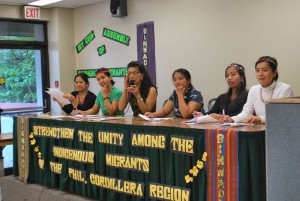
From left: Marivic Kalagui, Secretary-General; Cristy Bagni, Education Officer; Geralda Cobsilen, Vice- Chairperson; Jennifer Owatan, Chairperson; Nellie Angagca, Treasurer; Bridge Dang-ay, Solidarity Officer.
The first Migrante Canada organization by, of and for, the Philippine Cordillera indigenous peoples – Binnadang- Migrante – was born to the sound of gongs and dancing on October 29, 2011. Its first cry was “unity”; its second was“assert migrant’s rights; and its third and fourth twin cries were: “ engage in the struggle of indigenous peoples’ rights for self-determination” and “advance the struggle for genuine democracy, national freedom and independence”!
The birth is considered by many as a groundbreaking event because the launch took place just five months after the inception of Binnadang as an organizing committee that was created to plan the 2011 Cordillera Day. It is also groundbreaking in that many of its members and officers come from previously established Cordillera organizations in Toronto, and in fact, has been warmly welcomed by these organizations. As the founder and adviser of BIBAK Mr. Matthew Pattong, who acted as COMELEC officer at the launch, remarked, Binnadang-Migrante is not to be seen as divisive of the indigenous peoples of the Cordillera, but as a new and creative force in the Filipino community that seeks noteworthy goals.
The remark seems, to many observers, to point out that the organization has another groundbreaking goal. It is clear from its objectives that Binnadang-Migrante seeks to unify the peoples of the Cordillera for migrant workers’ rights and self-determination, but, as stated in the Constitution’s preamble, it sees that the indigenous Filipinos’ struggle for self-determination “can only be realized in conjunction with the advance of the national struggle”.
Binnadang-Migrante was formally launched in a founding general assembly that was well-attended by organizations representing the peoples of Benguet, Ifugao, Bontoc and Sagada. Guests who observed the proceedings and celebrated with the members rounded off the number of attendees to 56. They were mostly members of iWWorkers, Philippine Solidarity Network, GABRIELA-Ontario, PATAC, Migrante-Ontario, KAIROS and Anak-Bayan Toronto. Faculty and students from the Labour Education Centre , a centre situated in the Ontario Federation Labour building where the launch was held, also attended.
“Binnadang” means solidarity and helping each other, and, as their Constitution and By-Laws state, Binnadang-Migrante members are committed to be true to their name, in order to attain their objectives. In full hearing of their guests, members in attendance ratified the Constitution and By-Laws, as well as their General Program of Action, with hardly any suggestions for change.
In another novel move, the body also chose – from three different alternatives suggested by Mr. Pattong – to elect all members of its organizing committee to be its officers. It then authorized them to choose among themselves who would take the various positions. Elected were: Nelly Angagca, Cristy Bagni, Geralda Cobsilen, Bridge Cosme Dang-ay, Annabelle Fuchay, Marivic Kalagui, and certainly not the least, Jenny Owatan. These were the women who had come together to plan the May 7 2011 Cordillera Day, taking over the task from the Philippine Solidarity Network and Migrante-Ontario, which started organizing the annual event in 2009. Last year, 2010, BIBAK and an Ifugao group were mobilized to take part in it. The women , caregivers from the Cordillera region who were members of the Association of Filipino Women Workers, were intensely challenged by the fact that people organizing and celebrating Cordillera Day in Canada were not from the Cordillera. They decided to invite other Cordillera groups to help organize the event, and undaunted by the fact that only a few responded, they took the lead.
Historians have observed that courageous action and unity mark the Cordillera region’s history from the start of the Spanish conquest of the Philippines, and this was understandably a focus of praises from many speakers at the launch. A few highlights of the Cordillera people’s contemporary history of united struggle were noted. One was the Ibaloi opposition against a dam that government wanted to build in 1951, and in 1984, the remarkable fight of the Tinguian and Kalinga people against the Marcos government’s plan to build the Chico River Dam and enforce the Cellophil rubber-tree plantation project.
A brief glance at the achievements of Binnadang before its launch shows the organizers’ commitment to oppose the many forms of aggression against the Cordillera. This notably includes their protest against the resulting fact that many of them have no choice but to leave the Cordillera and seek escape from the continuing plunder. Two achievements are especially notable. One was their participation in the Kairos-organized event on the World Day for Indigenous Peoples, the theme of which was “Roll down the United Nations Declaration on the Rights of Indigenous Peoples”. The other was the facilitation by two of their members at University of Toronto workshops on the issue of mining injustice.
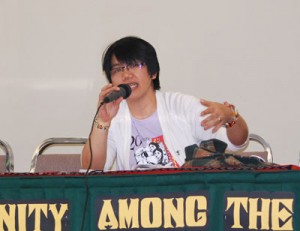
Vernie Yocogan-Diano delivered an inspiration talk for the day. She is from Innabuyog, a Cordillera women’s organization whose membership is under the umbrella of GABRIELA Philippines. In Canada on a speaking tour (part of an international Living Courage program), Yocogan-Diano said that her tour was remarkable because it involved sharing with women’s rights defenders, and was a venue where the women of the global South (“developing countries”) and the global North (“wealthy countries”) could together analyze their parallel issues. She also reported that this group of women’s rights defenders was able to speak in front of the Senate Committee on Human Rights.
Speaking of “home” (the Philippines), she asked: “What kind of home would you like to return to?” and then followed that up with present conditions in the Cordillera. The land, she said, was 66% given over to foreign mining corporations and wealthy local mining companies. As a result, militarization has increased, and additionally, the use of women as a tool of war has also increased. A recent military strategy is for soldiers to marry local women in order to enter community, and then later leave them and their offspring when their military duties are done.
She described Innabuyog as an organization determined to join in the people’s struggle so that the foreigners and rich individuals will not continue to ruin to the wealth of the Philippines, and so encouraged Binnadang-Migrante and other migrant organizations to work and support the struggles of people in the Philippines.
She also saw an important reason for organizing Binnadang although there are already other organizations in the Cordilleran community and migrant workers’ community. Although Binnadang has its own focus, she said, it would also be a strong addition to organizations helping in each other since they had struggles in common.
In ending, she exhorted them to persevere, quoting the words of Macli-ing Dulag, the great leader of the 1984 protest against the Chico River Dam: “If you do not fight, you die anyway, if you fight, you die honourably. I urge you, fight.”
A 3 minute silence was then asked of the audience to honour the victims of desecration by the military in Abra, in the Cordilleras. Binnadang’s Bridge Cosme Day-ang was visibly moved, as she recounted the killing and mutilation of 8 bodies which the military justified by saying that the victims were NPA (New People’s Army) members.
Dr. Chandu Claver, who heads Bayan Canada and is also from the Cordillera, sent a solidarity message from Vancouver, wherein he said that as migrants, we have the opportunity and duty, to develop a higher kind of consciousness, and to be more informed about events in the Philippines.
An overseas solidarity message from the Cordillera Alliance of Hong Kong was read, to much applause.
Meanwhile, Bayan Toronto’s speaker Alex Felipe contextualized the Cordillera’s ruin of 66% of its lands due to mining corporations within a national perspective of 30% of Philippine lands given over to mining. He emphasized that 75% of mining corporations now in the country are Canadian, which makes mining in the Philippines a Canadian issue, and added that Placer Dome has been there since the 1950s. It should make us realize, he said, that the tax dollars we pay go into mining Philippine natural resources. He also spoke of the connection between mining and the migration of Filipinos.
Mithi Esguerra from the youth organization Anak-Bayan spoke of the Cordillera youth as a source of inspiration for all youth, because of their history of resistance. She also spoke of culture as being very much dependent on the power of self-determination, and so urged on all youth to heed the call of the times.
Ben Corpuz of PATAC (Philippine Association of Toronto for Arts and Culture)also spoke of the fact that the Cordillera peoples are among the few indigenous peoples who have kept most of their culture intact, and whose historical struggle for self-determination is a very strong source of inspiration.
GABRIELA-Ontario’s Petronila Cleto praised the historical perseverance of the Cordillera peoples to resist colonization and oppression, and spoke of the Spaniards’, and later, the Americans’ classification of some people’s as “indigenous” and others as “non-indigenous” as a strategy to divide the Filipino people, and thus conquer. It was the colonizer’s cover-up of the successful resistance of their people, so others would be blissfully comfortable in their subjugation. Binnadang, she said, would help lead us away from this manufactured division, and together with other organizations, would go forwards to achieve genuine national unity and freedom.
An Interpretative dance on the theme of fighting to save the environment was performed by Binnadang ladies. An adopted daughter of Binnadang, Maru Maesa of iWWorkers and Chair of Migrante-Canada, was part of the group.
The launch ended as it started, with a community dance accompanied by gongs and led by elders and respected members of the community.
The courageous troops of indigenous people marches on!
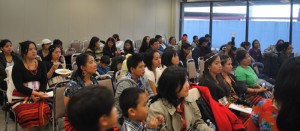
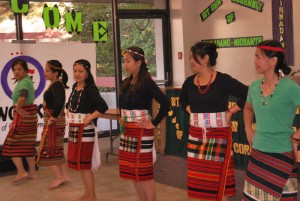
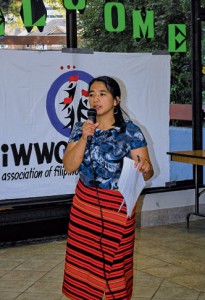
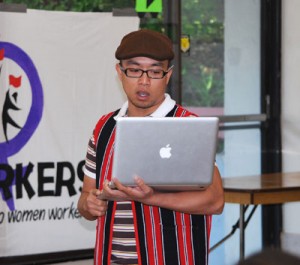
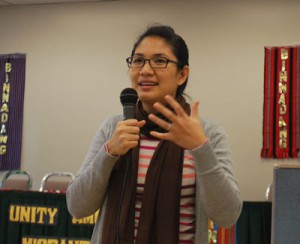
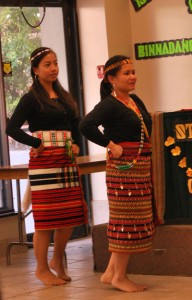
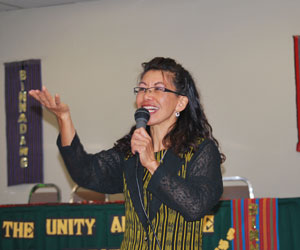
Comments (0)